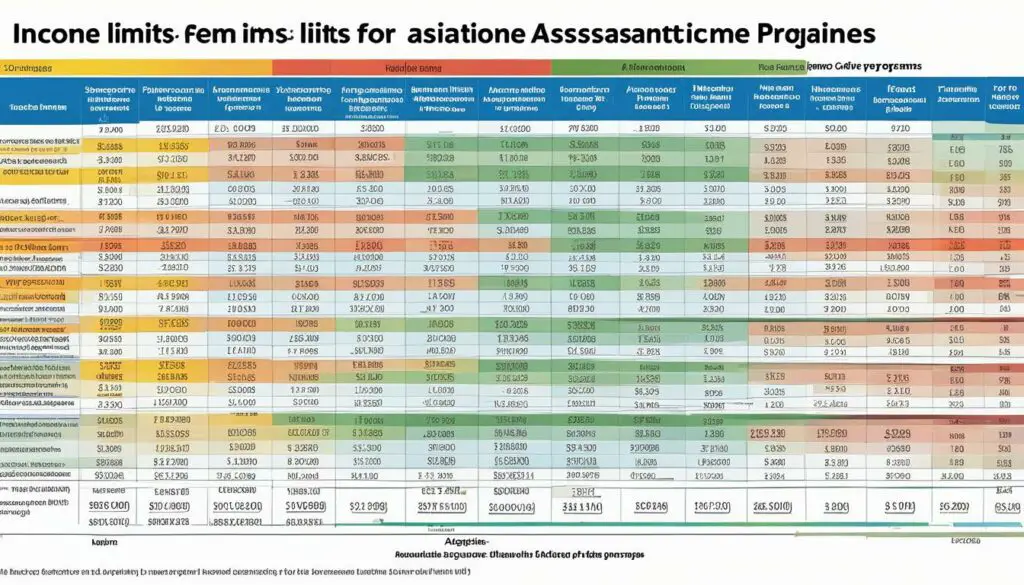Originally posted on December 20, 2023 @ 4:32 pm
Welcome to our comprehensive guide on the Massachusetts food stamps income limit. If you are a Massachusetts resident seeking assistance from the Supplemental Nutrition Assistance Program (SNAP), it is essential to understand the income limits set by the Massachusetts Department of Transitional Assistance (DTA). SNAP benefits can provide vital support to help you and your household access nutritious food and other assistance programs.
Table of Contents
Key Takeaways:
- SNAP benefits are administered by the Massachusetts DTA for residents in need of food assistance.
- Eligibility for SNAP is based on household composition, income, and certain expenses.
- The income limits for SNAP in Massachusetts vary depending on the size of the household.
- Individuals with disabilities can receive additional assistance when applying for SNAP benefits.
- Applying for SNAP benefits can be done online, by phone, by mail, by fax, or in person.
Understanding SNAP Eligibility

When it comes to accessing the Supplemental Nutrition Assistance Program (SNAP), understanding the eligibility requirements is crucial. SNAP eligibility is determined by factors such as household composition, income, and certain expenses. It’s important to have a clear understanding of these criteria to determine if you qualify for SNAP benefits.
A household, according to SNAP guidelines, includes anyone with whom you purchase and cook most of your meals. This can include family members, roommates, or even extended family members living under the same roof.
When it comes to income, SNAP takes into account various sources to determine eligibility. These sources can include wages, cash assistance, Social Security benefits, unemployment insurance, child support, and more. It’s essential to report all sources of income when applying for SNAP benefits to ensure accurate eligibility assessment.
Expenses, on the other hand, are also considered during the eligibility determination process. Certain expenses, such as rent/mortgage payments, utilities, and child care costs, can affect your eligibility for SNAP benefits. It’s essential to provide detailed information about your expenses to determine your eligibility accurately.
Income Sources Considered for SNAP Eligibility
SNAP takes into account income from various sources when determining eligibility. Some of the income sources that are considered include:
- Wages
- Cash assistance
- Social Security benefits
- Unemployment insurance
- Child support
- And more
Note: It is important to consult the official SNAP guidelines and refer to the specific income and expense calculations used in your state for accurate eligibility assessment.
“SNAP eligibility is determined by factors such as household composition, income, and certain expenses. It’s important to have a clear understanding of these criteria to determine if you qualify for SNAP benefits.”
| Household Size | Maximum Monthly Income |
|---|---|
| 1 | $2,430 |
| 2 | $3,287 |
| 3 | $4,144 |
| 4 | $5,001 |
| 5 | $5,858 |
| 6 | $6,715 |
| 7 | $7,572 |
| 8 | $8,427 |
Snap Eligibility Chart for Massachusetts

The SNAP eligibility chart provides the maximum monthly income limits for households in Massachusetts. These income limits are based on the size of the household and determine eligibility for SNAP benefits. Review the chart below to see the income limits based on the number of people in the household:
| Household Size | Maximum Monthly Income |
|---|---|
| 1 | $2,430 |
| 2 | $3,287 |
| 3 | $4,143 |
| 4 | $4,999 |
| 5 | $5,855 |
| 6 | $6,711 |
| 7 | $7,567 |
| 8+ | $8,427 |
Each additional person beyond eight adds $857 to the maximum monthly income limit. It is important to note that the maximum income limit does not guarantee a specific benefit amount. The amount of benefits received may be different based on the household’s income and expenses. It is also important to mention that during the COVID-19 pandemic, all households receive at least the maximum benefit amount.
Here is an image that displays the SNAP eligibility chart:
Assistance for Individuals with Disabilities

Individuals with disabilities can receive extra help or accommodations when applying for SNAP benefits. This includes assistance for individuals with mental, physical, sensory, learning, intellectual, cognitive, or developmental disabilities. The Department of Transitional Assistance provides language help, including interpreters in over 100 languages. Individuals can also appoint an authorized representative to assist with the application process and shopping. If there are safety concerns or other issues related to domestic violence, there is help available through the Domestic Violence Unit.
Accommodations for Individuals with Disabilities
When applying for SNAP benefits as an individual with disabilities, it’s essential to access the available accommodations tailored to your specific needs:
- Language Assistance: The Department of Transitional Assistance provides language help, including interpreters in over 100 languages. Language should not be a barrier to receiving SNAP assistance.
- Authorized Representative: Individuals can appoint someone they trust, such as a family member or friend, as an authorized representative to assist with the application process and shopping. This support ensures that individuals with disabilities can navigate the program effectively.
- Domestic Violence Support: In situations where safety concerns arise due to domestic violence, the Domestic Violence Unit can provide assistance and guidance to individuals in need.
By offering these additional supports, Massachusetts aims to ensure that individuals with disabilities can fully access SNAP benefits and receive the assistance they need.
“Access to SNAP benefits should be inclusive and accommodating for everyone, including individuals with disabilities. Massachusetts strives to provide language help, authorized representatives, and support for domestic violence situations to ensure equal opportunities for all.”
Accommodations for Individuals with Disabilities
| Accommodation | Description |
|---|---|
| Language Assistance | Interpreters available in over 100 languages |
| Authorized Representative | Individuals can appoint someone to assist with the application process and shopping |
| Domestic Violence Support | Assistance available for individuals facing safety concerns related to domestic violence |
Applying for SNAP Benefits
Applying for SNAP benefits is a straightforward process that can be done through various channels, including online, by phone, by mail, by fax, or in person. By providing some basic information, you can start the application process and be on your way to accessing SNAP benefits.
To apply, you will need to provide your name, address, and signature as part of the application. It’s important to include accurate and complete information to avoid any delays in processing your application. The more information you provide, the faster the processing time can be for your SNAP benefits.
If you’re applying online, you can visit the official website of your state’s SNAP program to start the application process. The online application typically offers a user-friendly interface with step-by-step instructions, making it convenient and accessible for applicants.
If you prefer to apply by phone, you can call your local SNAP office or the SNAP hotline. Trained representatives will guide you through the application process and help answer any questions you may have along the way.
For those who prefer traditional methods, applying by mail or fax is also an option. You can obtain a copy of the SNAP application form from your local SNAP office or download it from their website. Fill out the form, sign it, and send it to the designated address or fax number mentioned on the form.
If you require assistance during the application process, don’t hesitate to reach out to friends, family members, or community partners. They can provide support and guidance to ensure that you complete the application accurately and submit it on time.
It’s important to note that the benefits you receive may be retroactive to the date of your application if approved. So, it’s essential to submit your application promptly to avoid missing out on any potential benefits.
If you have any health problems or disabilities that may require accommodations, be sure to include this information in your application. The SNAP program offers assistance and accommodations for individuals with specific needs, ensuring that everyone has equal access to the benefits they are eligible for.
The SNAP application is available in multiple languages to cater to the diverse population it serves. This helps ensure that language is not a barrier when applying for benefits, allowing more individuals to take advantage of the program.
Now that you are familiar with the application process, you can confidently apply for SNAP benefits and access the assistance you need to meet your nutritional needs.
Income Guidelines for Other Assistance Programs

The Massachusetts Department of Transitional Assistance (DTA) offers various assistance programs in addition to SNAP. These programs provide financial support to eligible individuals and families who are facing economic challenges. The income guidelines for these programs ensure that assistance is targeted to those who need it the most.
Transitional Aid to Families with Dependent Children (TAFDC) Program
The TAFDC program provides temporary cash assistance to families with dependent children. To qualify for TAFDC, your family’s income must meet the program’s income guidelines. The income limits are based on the size of your family and the maximum amount of monthly income you can have to be eligible. Here is an overview of the income limits for the TAFDC program in Massachusetts:
| Family Size | Maximum Monthly Income |
|---|---|
| 1 | $584 |
| 2 | $784 |
| 3 | $985 |
| 4 | $1,185 |
| 5 | $1,386 |
Please note that these income limits are subject to change, and it is important to check with the DTA for the most up-to-date information.
Emergency Aid to the Elderly, Disabled and Children (EAEDC) Program
The EAEDC program provides financial assistance to individuals and families who are elderly, disabled, or the caretakers of dependent children. The program’s income limits determine eligibility and the amount of assistance you may receive. Here are the income limits for the EAEDC program in Massachusetts:
| Family Size | Maximum Monthly Income |
|---|---|
| 1 | $303 |
| 2 | $375 |
| 3 | $429 |
| 4 | $450 |
| 5 | $472 |
State Supplement Program (SSP)
The SSP provides cash assistance to individuals who are eligible for Supplemental Security Income (SSI) payments from the federal government. The income limits for the SSP program are based on the SSI income limits and vary depending on the individual’s living situation. The DTA can provide more information on the income guidelines for the SSP program.
These income guidelines ensure that the assistance programs offered by the DTA reach those who need it the most. If your income falls within the guidelines for any of these programs, you may be eligible for financial assistance to help you meet your basic needs.
Gross Income Test for SNAP Eligibility

SNAP eligibility in Massachusetts is determined by the gross income test, which requires households to have a gross income that is below 200% of the federal poverty level. Gross income refers to the income before any taxes or deductions are taken into account.
The gross income limits for SNAP eligibility depend on the size of the household. Here are the income limits for different household sizes:
| Household Size | Gross Income Limit |
|---|---|
| 1 | $2,430 |
| 2 | $3,287 |
Please note that these income limits are effective as of February 2023. It’s important to stay updated with the latest income guidelines to determine your SNAP eligibility.
SNAP provides a crucial support system for individuals and families facing food insecurity. By ensuring that gross income is within the established limits, more households can access the assistance they need to purchase nutritious food and improve their well-being.
The gross income test serves as a way to evaluate a household’s financial situation and ensure that SNAP benefits reach those most in need. It helps to create a fair and equitable system where assistance is provided to those who meet the income criteria.
When considering SNAP eligibility, it’s also important to remember that gross income is just one aspect. Other factors such as household composition, net income, and allowable deductions are taken into account. The SNAP program aims to provide support to individuals and families who are struggling to afford an adequate diet.
By implementing the gross income test, SNAP establishes income guidelines that help allocate resources effectively and ensure that the program reaches those who need it most. It is a crucial step in maintaining the integrity of the program and ensuring that assistance is provided to those who truly require it.
Snap Eligibility for Specific Household Situations

Snap eligibility criteria may vary for specific household situations. Here are the eligibility requirements for households with different characteristics:
Elderly or Disabled Households:
- Elderly or disabled households do not undergo a gross income test for SNAP eligibility.
- However, they must meet the asset and net income tests to qualify for SNAP benefits.
Households with Children or Pregnant Women:
- Households with children or pregnant women may receive a minimum SNAP benefit if their gross income is below 200% of the federal poverty level.
Households with Sanctioned Members:
- Households with members under sanction due to fraud have a lower gross income threshold of 130% of the federal poverty level.
In addition to the above criteria, there may be additional eligibility requirements and considerations based on specific household situations. It is important to carefully review the SNAP eligibility guidelines to determine eligibility based on individual circumstances.
Data Table: Specific Household Situations and SNAP Eligibility
| Household Situation | SNAP Eligibility Criteria |
|---|---|
| Elderly or Disabled Households | No gross income test; must meet asset and net income tests. |
| Households with Children or Pregnant Women | Minimum SNAP benefit if gross income is below 200% of the federal poverty level. |
| Households with Sanctioned Members | Gross income threshold of 130% of the federal poverty level. |
Please Note: The eligibility criteria provided above are for illustrative purposes only. It is recommended to refer to the official SNAP program guidelines specific to your state for comprehensive information on eligibility requirements.
Additional Resources and Support

SNAP recipients have access to various additional resources and support to enhance their food assistance experience. These resources aim to promote healthier eating habits, provide financial relief, and foster educational opportunities for SNAP recipients and their families.
Nutrition Education Classes
As part of the SNAP program, nutrition education classes are available to help recipients make informed choices about the foods they purchase and consume. These classes cover a wide range of topics, including meal planning, healthy cooking techniques, and budget-friendly shopping strategies. By participating in these classes, SNAP recipients can gain valuable knowledge and skills to improve their overall health and well-being.
Utility Discounts
The Department of Transitional Assistance recognizes the financial strain that utility costs can impose on SNAP recipients. To alleviate some of these expenses, eligible individuals may qualify for utility discounts through specific programs. These discounts can help reduce the burden of utility bills, allowing recipients to allocate their remaining resources towards other essential needs.
Free School Meals
SNAP recipients with school-aged children can benefit from free school meals programs. These programs ensure that children receive nutritious meals even outside of the home. By eliminating the cost of school meals, families can allocate their SNAP benefits towards other necessary expenditures, providing additional financial relief.
Discounts for Cultural Institutions
SNAP recipients may enjoy discounted admission to various cultural institutions. These partnerships between the Department of Transitional Assistance and museums, zoos, aquariums, and other cultural establishments enable individuals and families to explore and engage with enriching experiences at a reduced cost. This allows for greater access to educational and cultural opportunities, promoting personal growth and enrichment.
Discounted Internet through the Affordable Connectivity Program
In today’s digital age, access to the internet is essential for many aspects of everyday life. SNAP recipients can benefit from the Affordable Connectivity Program, which offers discounted internet services. This program aims to bridge the digital divide and ensure that all individuals have equal opportunities for online learning, job searching, communication, and access to vital resources.
The Department of Transitional Assistance provides guides and resources to assist SNAP recipients in navigating the program effectively. These resources offer valuable information and support to ensure that recipients can access the benefits and assistance they are entitled to. By taking advantage of these additional resources, SNAP recipients can enhance their overall well-being and improve their quality of life.
FAQs About SNAP Income Limit in Massachusetts
Here you will find answers to commonly asked questions about the income limits for the Supplemental Nutrition Assistance Program (SNAP) in Massachusetts.
-
Q: What is the income limit for SNAP benefits in Massachusetts?
A: The income limit for SNAP benefits in Massachusetts varies based on household size. The maximum monthly income limit ranges from $2,430 for a household of one to $8,427 for a household of eight. Each additional person beyond eight adds $857 to the maximum monthly income limit. -
Q: How is household size determined for SNAP eligibility?
A: Household size includes anyone with whom you purchase and cook most of your meals. This can include family members, roommates, or other individuals who share meals with you on a regular basis. -
Q: Do all sources of income count towards SNAP eligibility?
A: Yes, when applying for SNAP benefits, it is important to report all sources of income, including wages, cash assistance, Social Security, unemployment insurance, and child support. The total income from these sources is taken into account when determining eligibility. -
Q: Are there different income limits for households with disabilities?
A: Households with individuals who have disabilities must meet the asset and net income tests instead of the gross income test. These households may have different income limits and eligibility criteria. -
Q: Can I receive retroactive benefits if my application is approved?
A: Yes, SNAP benefits can be retroactive to the date of application if approved. It is important to provide accurate information and complete the application as soon as possible.
If you have specific questions about your eligibility or need further assistance, you can contact the Massachusetts Department of Transitional Assistance directly.
Conclusion
In conclusion, the Massachusetts food stamps income limit is an important factor in determining eligibility for SNAP benefits. The income limits vary based on household size and composition, with the maximum monthly income limit ranging from $2,430 for a household of one to $8,427 for a household of eight. It is crucial to accurately report all sources of income when applying for SNAP benefits to ensure eligibility is correctly assessed.
Furthermore, individuals with disabilities can access additional resources and accommodations to support their application process. The Massachusetts Department of Transitional Assistance provides language help in over 100 languages, interpreters, and the option to appoint an authorized representative for assistance. Safety concerns related to domestic violence are also addressed through the Domestic Violence Unit.
Applying for SNAP benefits can be done online, by phone, by mail, by fax, or in person. It is recommended to provide as much information as possible in the application to expedite processing time. Additionally, community partners, friends, and family members can offer assistance in completing the application. Once approved, SNAP recipients can access a variety of resources and support, including nutrition education classes, utility discounts, and discounted internet through the Affordable Connectivity Program.
FAQ
What is SNAP?
SNAP, also known as the Supplemental Nutrition Assistance Program, is a food assistance program administered by the Massachusetts Department of Transitional Assistance (DTA) that provides monthly funds on a debit-like EBT card to purchase food and other types of assistance.
How is SNAP eligibility determined?
SNAP eligibility is based on factors such as household composition, income, and certain expenses. Income from various sources, including wages, cash assistance, Social Security, and child support, is taken into account when determining eligibility.
What are the income limits for SNAP in Massachusetts?
The income limits for SNAP in Massachusetts vary based on household size. For example, a household of one can have a maximum monthly income of $2,430, while a household of eight can have a maximum monthly income of $8,427. Each additional person adds $857 to the maximum monthly income limit.
Are there accommodations for individuals with disabilities?
Yes, individuals with disabilities can receive extra help or accommodations when applying for SNAP benefits, including assistance for various disabilities and language help in over 100 languages.
How can I apply for SNAP benefits?
You can apply for SNAP benefits online, by phone, by mail, by fax, or in person. The application requires basic information such as name, address, and signature.
Are there income guidelines for other assistance programs?
Yes, the Department of Transitional Assistance in Massachusetts has income guidelines for various assistance programs in addition to SNAP, including the TAFDC program, EAEDC program, and SSP.
What is the gross income test for SNAP eligibility?
Most SNAP households in Massachusetts must have gross income under 200% of the federal poverty level to qualify. The gross income limits depend on the household size.
What is the SNAP eligibility for specific household situations?
SNAP eligibility varies for specific household situations. Elderly or disabled households have different eligibility criteria, and households with children or pregnant women receive a minimum SNAP benefit if their gross income is under 200% of the federal poverty level.
Are there additional resources and support for SNAP recipients?
Yes, SNAP recipients can access additional resources and support, including nutrition education classes, utility discounts, free school meals, discounts for cultural institutions, and discounted internet through the Affordable Connectivity Program.
What are some frequently asked questions about the income limits for SNAP in Massachusetts?
Some frequently asked questions include the income limits based on household size, how to apply for SNAP benefits, and accommodations for individuals with disabilities.
Source Links
- https://www.mass.gov/how-to/apply-for-snap-benefits-food-stamps
- https://www.mass.gov/lists/department-of-transitional-assistance-program-eligibility-charts-and-tables
- https://www.masslegalservices.org/content/64-there-gross-income-test-snap
See also:
Leave a Reply